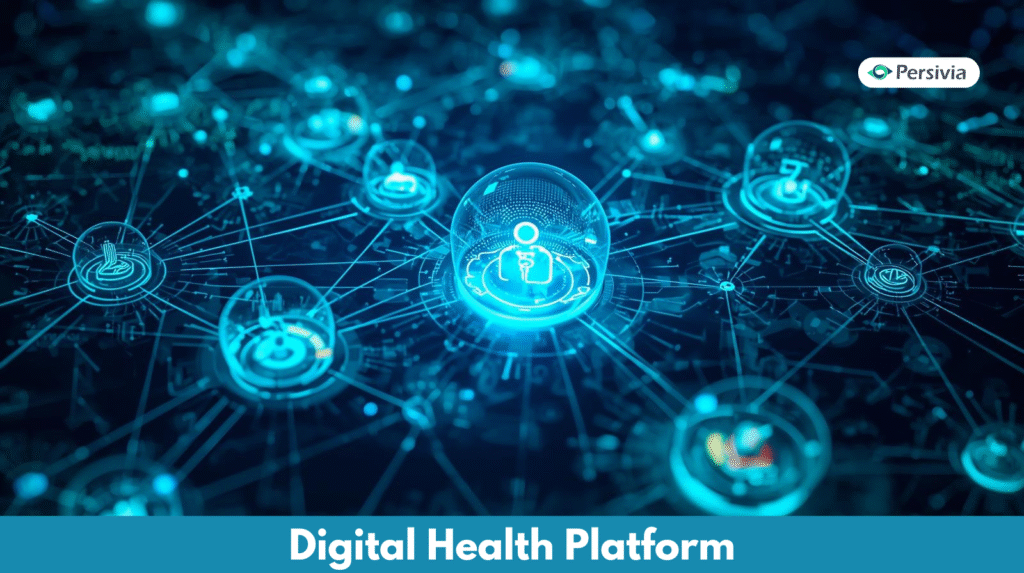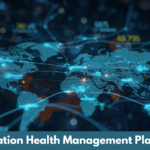Healthcare is no longer working in silos. Patient histories must be available immediately to providers. Payers monitor quality measures on thousands of members. Patients demand smooth liaisons between the specialists, primary care, and their health plans. Such things require infrastructure qualified for processing immense volumes of data and providing real-time insights.
This is made possible by a Digital Health Platform. How? Well, it unifies clinical and claims data, uses AI to detect care gaps, and delivers recommendations directly to clinicians at the point of care. These platforms turn raw data into actionable insights that improve outcomes, reduce costs, and help healthcare organizations stay competitive in value-based models.
What is a Digital Health Platform?
Today’s healthcare system needs infrastructure that connects all stakeholders through shared data, advanced analytics, and intelligent processes. The right platform not only stores information but also reshapes how organizations deliver care and manage populations.
A Digital Health solution gathers data from EHRs, claims systems, labs, pharmacies, and medical devices. It works with these data processing AI models and provides them through dashboards, care management tools, and point-of-care applications.
Core capabilities include:
- Data aggregation from disparate clinical and administrative sources
- Real-time analytics powered by artificial intelligence
- Interoperability with major EHR systems through bi-directional connectivity
- Modular design that adapts to ACOs, health plans, and provider networks
- Workflow automation that reduces manual tasks for care teams
The platform approach eliminates integration headaches by operating everything through a unified infrastructure. This creates a consistent experience across different departments and organizations.
The Four Pillars of Digital Health Infrastructure
Connected ecosystems require four foundational layers working in harmony. Each pillar addresses specific operational needs while contributing to overall system performance. Organizations missing any single component struggle to achieve meaningful results in value-based care.
Data Management: Building the Foundation
Healthcare produces structured data, such as laboratory values, and unstructured data, such as clinical notes. An effective platform manages both structured and unstructured data efficiently, standardizes them, and makes everything searchable within seconds.
Key functions:
- Acquisition: Pulling data from EHRs, claims feeds, HIEs, and external sources
- Integration: Mapping different coding systems and resolving duplicate records
- Storage: Maintaining longitudinal patient records with complete audit trails
- Delivery: Pushing information to applications, dashboards, and external partners
Organizations should have complete control over their data. Cloud-based infrastructure can manage the technical intricacy of FHIR APIs, HL7 feeds, and flat file imports and provide flexibility to teams on how they organize and access data.
Analytics: Converting Data Into Decisions
Basic reporting indicates what occurred last month, but advanced analytics indicate what will occur next quarter. This predictive ability comes from Healthcare AI and machine learning models trained on millions of patient interactions.
Analytics layers include:
- Descriptive analytics tracking HEDIS measures and STAR ratings
- Predictive analytics identifies patients likely to be hospitalized
- Prescriptive analytics recommending evidence-based care pathways
- Real-time analytics delivering point-of-care alerts for care gaps
The analytics engine takes less than two seconds to process queries. Care managers are not able to wait 10 minutes to get risk reports. Doctors require immediate summaries of patients on 15-minute visits.
Quality Management: Driving Performance Improvement
Value-based contracts tie reimbursement directly to quality metrics. Medicare Advantage plans receive bonuses for high STAR ratings. ACOs share savings when they hit HEDIS benchmarks. Missing these targets costs millions in lost revenue.
Platforms monitor quality through automated measure calculation, member attribution, care gap identification with prioritization, workflow assignment, routing tasks to appropriate staff, and progress tracking showing measure performance over time.
| Quality Measure | Data Sources | Data Sources |
| HEDIS | Claims, EHR, Lab | Monthly |
| STAR Ratings | Claims, EHR, Surveys | Quarterly |
| HCC Coding | Claims, Encounters | Continuous |
Note: Organizations using integrated quality modules close 40% more care gaps than those using manual tracking.
Risk Management: Stratifying Populations
Not all patients require the same level of attention. Some individuals manage chronic conditions effectively with regular annual checkups. Others cycle through emergency rooms and struggle with medication adherence. Risk stratification directs resources where they create the most impact.
Effective risk models consider:
- Hierarchical Condition Categories (HCC) for diagnosis-based scoring
- Pharmacy utilization patterns indicate uncontrolled conditions
- Social determinants like housing instability or food insecurity
- Historical utilization, including hospitalizations and ER visits
If a diabetic patient misses an A1C test, the system automatically flags them for outreach. Care managers are alerted to the risk of addiction when an individual orders an opioid prescription post-surgery.
How AI Powers Modern Digital Health Platforms
Artificial intelligence is the intelligence layer that will automate and make insights visible without the user having to run reports. These engines run in the background, continuously analyzing new data and detecting situations that require intervention.
Healthcare AI engines do not rely on people clicking a button, but instead on the continuously running engines. They read incoming streams of data, determine patterns, and invoke workflows based on configurable rules and machine learning models.
Core AI capabilities:
- Natural language processing, extracting clinical concepts from physician notes
- Predictive modeling for forecasting hospital admissions and disease progression
- Pattern recognition detecting fraud, waste, and abuse in claims
- Workflow optimization routing tasks based on staff capacity and patient acuity
The AI learns from outcomes. When a recommended intervention prevents hospitalization, the model strengthens that pathway. When patients don’t respond to outreach strategies, the system adjusts its approach automatically.
Care managers once manually reviewed hundreds of charts to find patients needing outreach. Now, algorithms scan entire populations overnight and deliver prioritized work lists each morning. Staff focus on patient interactions instead of data mining.
Population Health Management at Scale
Traditional medicine is a response to a disease. Someone becomes diabetic, and then he or she gets medicine. Population health operates at the upstream level, induced by diagnosing pre-diabetics and stopping the further development of the disease. This preventive approach improves outcomes and reduces costs across entire member populations.
Clinical Programs and Care Pathways
Clinical programs offer systematic means of dealing with certain conditions. The programs address a specified group with evidence-based interventions. The pathways that diabetic patients are placed on are quarterly A1C testing, annual eye checkups, and monitoring of medication adherence.
Program components include eligibility criteria, outreach guidelines, escalation protocols for intensive care, and outcome measures tracking the program’s impact on cost and quality.
Quality Dashboards That Drive Action
Executives need portfolio views while frontline staff need individual member lists. Effective dashboards serve all audiences by combining visualization with direct workflow integration.
Dashboard features:
- Measure performance displayed against benchmarks and goals
- Trend analysis showing improvement or decline over time
- Gap lists providing names and contact information for outreach
- Intervention tracking, recording completion status for assigned tasks
Users can move directly from identifying problems to assigning outreach tasks within the same interface.
Point of Care Tools: Bringing Data to Clinical Encounters
The best insights lose value if physicians can’t access them during patient visits. A care gap identified three days after an appointment accomplishes nothing. Real-time delivery at the point of care transforms data into better clinical decisions.
Full Patient View and Clinical Context
Complete patient views show everything relevant to care decisions in one place. This includes longitudinal clinical history from all settings, active medications from pharmacy data, laboratory results with trends, recent utilization, assigned care programs, social determinants, and insurance coverage status.
This context prevents errors and duplication. Physicians see that another specialist has already ordered a test. Care managers know about recent hospitalizations before making outreach calls.
Bi-Directional EHR Connectivity
Many integrations only read from EHR systems, creating a double documentation burden. True bi-directional connectivity means data flows both directions: platform-generated care summaries appear in EHR chart notes, quality documentation flows back to the platform, and care management interventions create encounter records.
Organizations implementing successful integrations see major reductions in documentation time.
Data Integration and Interoperability
Healthcare remains fragmented despite decades of standardization attempts. Hospitals use Epic, clinics use Cerner, health plans use claims systems, and labs use proprietary platforms. Each stores data differently using incompatible formats.
Organizations typically connect 10-50 data sources into their platform. Managing this complexity manually doesn’t scale, requiring pre-built connectors for common systems, configurable mapping tools, automated quality checks, and master data management, creating single patient identities.
The platform becomes the single source of truth. Rather than making a query to various systems, the applications access the built-in data store. This centralization enhances performance, consistency, and simplifies security management.
Supporting All Alternate Payment Models
Payment models determine what data organizations need and how they use it. Fee-for-service focuses on volume, while value-based care focuses on outcomes. Different models require different platform capabilities to work simultaneously.
Healthcare moves quickly with new regulations, mergers, and contract changes. Platforms built for one specific workflow break when requirements evolve. Composable design solves this through modular components combining in different configurations, configurable rules engines, open APIs enabling extensions, and scalable infrastructure handling growth from 10,000 to 1 million members.
| Payment Model | Key Platform Features |
| Key Platform Features | Quality dashboards, risk adjustment, and member engagement |
| ACO Shared Savings | Cost analytics, care management, and network performance |
| Bundled Payments | Episode grouping, variance analysis, and collaboration tools |
Wrap Up
The transition of healthcare to value-based care requires infrastructure that links the parties involved, uncovers insights, and automates processes. The Digital Health Platform offers this base with a combination of data management, AI-driven analytics, quality tracking, and point-of-care tools. Organizations using these capabilities achieve measurable improvements in cost reduction, care delivery, and staff satisfaction.
About Persivia
Persivia offers a full-fledged AI-based digital health platform, ‘CareSpace®’, aimed at a value-based care setting. It helps healthcare organizations boost STAR ratings, close care gaps, and streamline operations. Whether managing a Medicare Advantage plan, running an ACO, or coordinating across networks, CareSpace adapts to your needs with modular architecture. The result: connected care that improves outcomes and lowers costs.



